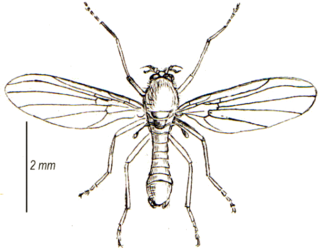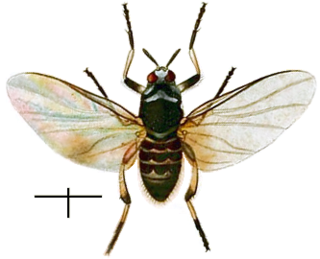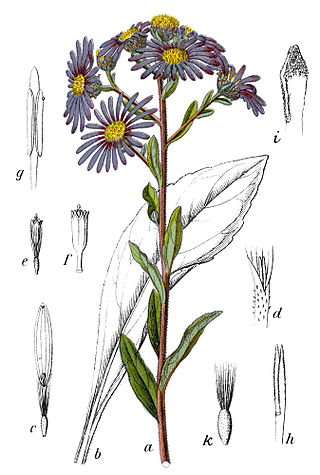
The Scrophulariaceae are a family of flowering plants, commonly known as the figwort family. The plants are annual and perennial herbs, as well as shrubs. Flowers have bilateral (zygomorphic) or rarely radial (actinomorphic) symmetry. The Scrophulariaceae have a cosmopolitan distribution, with the majority found in temperate areas, including tropical mountains. The family name is based on the name of the included genus Scrophularia L.

Gekkonidae is the largest family of geckos, containing over 950 described species in 64 genera. Members of the Gekkonidae comprise many of the most widespread gecko species, including house geckos (Hemidactylus), tokay geckos (Gekko), day geckos (Phelsuma), mourning geckos (Lepidodactylus) and dtellas (Gehyra). Gekkonid geckos occur globally and are particularly species-rich in tropical areas.

A black fly or blackfly is any member of the family Simuliidae of the Culicomorpha infraorder. It is related to the Ceratopogonidae, Chironomidae, and Thaumaleidae. Over 2,200 species of black flies have been formally named, of which 15 are extinct. They are divided into two subfamilies: Parasimuliinae contains only one genus and four species; Simuliinae contains all the rest. Over 1,800 of the species belong to the genus Simulium.

Thaumaleidae, the solitary midges or trickle midges, are a group of nematoceran flies related to the Ceratopogonidae, Chironomidae, and the Simuliidae. They are small, stocky, yellow to brown flies (3–4 mm). Very few species are known for this family. Larvae are found in films on rocks and the nonfeeding adults are usually found on foliage along the same streams in which the larvae are found. A few solitary midges are found in the Southern Hemisphere, but Thaumaleidae are generally an Holarctic family.

The Chironomoidea are a superfamily within the order Diptera, suborder Nematocera, infraorder Culicomorpha. This superfamily contains the families Chironomidae, Ceratopogonidae, Simuliidae, and Thaumaleidae.

The minute black scavenger flies or "dung midges", are a family, Scatopsidae, of nematoceran flies. Despite being distributed throughout the world, they form a small family with only around 250 described species in 27 genera, although many await description and doubtless even more await discovery. These are generally small, sometimes minute, dark flies, generally similar to black flies (Simuliidae), but usually lacking the humped thorax characteristic of that family.

Simulium is a genus of black flies, which may transmit diseases such as onchocerciasis. It is a large genus with several hundred species, and 41 subgenera.

Asteroideae is a subfamily of the plant family Asteraceae. It contains about 70% of the species of the family. It consists of several tribes, including Astereae, Calenduleae, Eupatorieae, Gnaphalieae, Heliantheae, Senecioneae and Tageteae. Asteroideae contains plants found all over the world, many of which are shrubby. There are about 1,135 genera and 17,200 species within this subfamily; the largest genera by number of species are Helichrysum (500–600) and Artemisia (550).
Gigantodax is a genus of 68 species of black flies distributed along the Andes from Mexico to Tierra del Fuego in Argentina.

The Simuliini is a tribe of black flies that contains over 2,000 species, with more than 1,800 in the genus Simulium. There are 19 living genera, and three genera only known from Cretaceous fossils.
Prosimuliini is a tribe of black flies. It contains over 140 living species, with more than a half of them in the genus Prosimulium. There are 6 living genera, and 2 genera that are only known from Cretaceous fossils.
The Parasimuliinae are a subfamily of Simuliidae containing only one genus and four species. Most species are rare, and some are cave dwellers, in western North America.
Parasimulium is a genus of black flies containing two subgenera and four species. They are found in western North America. Most species are rare, and some Canadian species are cave dwellers.
Araucnephia is a genus of South American black flies from Chile and Argentina. There are only 2 known species.

Austrosimulium is a genus of 31 species of black flies that are distributed in Australia and New Zealand. There are 2 subgenera: Austrosimulium whose species are principally from New Zealand, and Novaustrosimulium which are exclusively Australian. Austrosimulium is a sister genus to the monospecific Paraustrosimulium of South America.
Ectemnia is a genus of 4 species of black flies. They are distributed in North America.

The Chloropidae are a family of flies commonly known as frit flies or grass flies. About 2000 described species are in over 160 genera distributed worldwide. These are usually very small flies, yellow or black and appearing shiny due to the virtual absence of any hairs. The majority of the larvae are phytophagous, mainly on grasses, and can be major pests of cereals. However, parasitic and predatory species are known. A few species are kleptoparasites. Some species in the genera Hippelates and Siphunculina are called eye gnats or eye flies for their habit of being attracted to eyes. They feed on lachrymal secretions and other body fluids of various animals, including humans, and are of medical significance.
Prosimulium is a genus of black flies. There are at least 110 described species in Prosimulium.
Roger Ward Crosskey was a British entomologist who worked at the Commonwealth Institute of Entomology and at the Natural History Museum in London specializing in blackflies (Simuliidae), Tachinidae and the hymenopteran superfamily Evanioidea.
Pedrowygomyia is a genus of neotropical simuliid flies erected in 1998 from the Gigantodax cortesi species group of the 1925 genus Gigantodax after a cladistics analysis of the species groups recognized in the genus indicated that it was paraphyletic. The genus was named in recognition of the contributions to science of entomologist Petr Wolfgang Wygodzinsky. Pedrowygomyia originally comprised four species, P. cortesi, P. jatunchuspi, P. punapi and P. chacabamba, all described in 1989 from high-elevation areas in the Andean region. In 2020, a new species, P. hanaq, was described from the south-central Andes of Peru at an altitude above 4,000 m. Based on the pupal stage, the new species appears to be most closely related to P. punapi, a species known from Argentina, Bolivia, and Chile.











